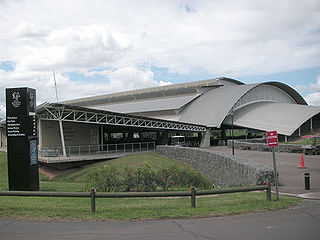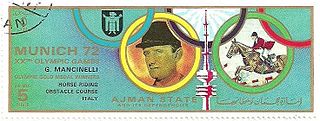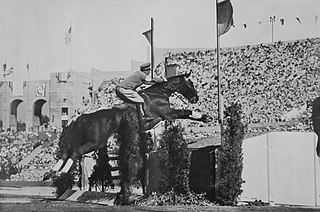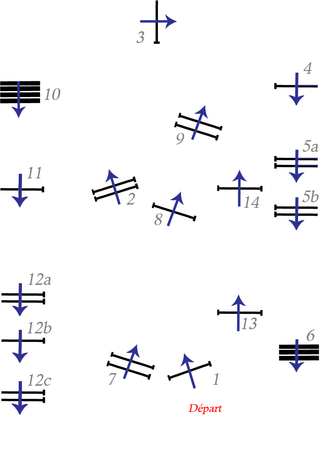
Equestrian at the 1980 Summer Olympics was represented by six events. All of them, with the exception of the Individual Jumping Grand Prix, were held in the Trade Unions' Equestrian Complex, which is situated in the Bitsa Forest Park. Individual Jumping Grand Prix was held in the Grand Arena of the Central Lenin Stadium at Luzhniki.
The equestrian events at the 1956 Summer Olympics were held in Stockholm due to the Australian quarantine regulations and included dressage, eventing, and show jumping. All three disciplines had both individual and team competitions. The competitions were held from 11 to 17 June 1956 at Stockholm Olympic Stadium. There were 158 entries from 29 National Olympic Committees: Argentina, Australia, Austria, Belgium, Brazil, Bulgaria, Cambodia, Canada, Denmark, Egypt, Finland, France, Germany, Great Britain, Hungary, Ireland, Italy, Japan, Netherlands, Norway, Portugal, Romania, Soviet Union, Spain, Sweden, Switzerland, Turkey, USA and Venezuela. This would be the first appearance for Australia, Cambodia and Venezuela in equestrian events.

Equestrian sports were first included in the Olympic Games in the Summer Olympics of 1900 in Paris. They were again included in 1912, and have been included in every subsequent edition of the Games. Currently, the Olympic equestrian disciplines are dressage, eventing, and show jumping. In each discipline, both individual and team medals are awarded. Since the XV Olympiad in Helsinki in 1952, women and men compete on equal terms.

The individual show jumping was an equestrian event held as part of the Equestrian at the 1964 Summer Olympics programme. The event was held on 24 October. There were 46 competitors from 17 nations. Each nation could have up to three riders. The event was won by Pierre Jonquères d'Oriola of France, the first rider to win two gold medals in individual jumping; he did so 12 years apart, with his first in 1952. It was France's third gold medal in the event overall, moving out of a tie with Italy at two for most all-time. Hermann Schridde, representing the United Team of Germany, took silver. Great Britain earned its second consecutive bronze in the event, this time with Peter Robeson taking the honors.

The individual show jumping at the 2008 Summer Olympics took place between 15 and 21 August, at the Hong Kong Sports Institute. Like all other equestrian events, the jumping competition was mixed gender, with both male and female athletes competing in the same division. There were 77 competitors from 29 nations. The event was won by Eric Lamaze of Canada, the nation's first victory in individual jumping and first medal of any color in the event since 1976. Silver went to Rolf-Göran Bengtsson of Sweden, that nation's first medal in individual jumping since 1932. American Beezie Madden, who had led through the three qualifying rounds in 2004 before a bad first final round put her in 30th overall in Athens, took the bronze medal in Beijing.

The individual show jumping was one of five equestrianism events on the Equestrian at the 1924 Summer Olympics programme. The competition was held on Saturday 27 July 1924. 43 riders from 11 nations competed. Nations were limited to four riders each; the team jumping event used the same results as this competition, with the top three individual scores counting for each national team. The individual event was won by Alphonse Gemuseus of Switzerland, with the nation winning its first victory in its debut in the individual jumping event. Tommaso Lequio di Assaba of Italy became the first person to win multiple medals in the event, taking silver to add to his 1920 gold. Adam Królikiewicz earned Poland's first individual jumping medal with his bronze.

The individual show jumping event, part of the equestrian program at the 2000 Summer Olympics, was held from 25 September to 1 October 2000 at the Sydney International Equestrian Centre 45 miles outside of Sydney, Australia. Like all other equestrian events, the jumping competition was mixed gender, with both male and female athletes competing in the same division. There were 74 competitors from 28 nations. Each nation could have up to 4 riders. The event resulted in a three-way tie for first and a medal jump-off. Dutch riders Jeroen Dubbeldam and Albert Voorn finished first and second in that jump-off, earning the Netherlands' first gold medal and second silver medal in individual jumping. Khaled Al Eid earned Saudi Arabia's first medal in the event with his bronze, finishing third in the jump-off.

The individual jumping in equestrian at the 2012 Olympic Games in London was held at Greenwich Park from 4 to 8 August. Like all other equestrian events, the jumping competition was mixed gender, with both male and female athletes competing in the same division. There were 75 competitors from 26 nations. The event was won by Steve Guerdat of Switzerland, the nation's first victory in individual jumping since 1924 and second overall. Gerco Schroder of the Netherlands took silver. Cian O'Connor of Ireland, who had been stripped of a gold medal in the event in 2004, earned bronze—Ireland's first medal in the event.

The individual show jumping at the 1928 Summer Olympics took place on 12 August 1928 at the Olympic Stadium in Amsterdam. Scores from the individual competition were summed to give results in the team competition. There were 46 competitors from 16 nations. Each nation could send a team of three riders; 15 nations did so, while Japan had a single rider. The event was won by František Ventura of Czechoslovakia, the nation's first medal in individual jumping. France earned its first medal in the event since 1912 with Pierre Bertran de Balanda's silver. Charles-Gustave Kuhn took bronze, putting Switzerland on the podium for the second consecutive Games.

The individual show jumping in equestrian at the 1972 Summer Olympics in Munich was held at Olympic Stadium on 3 September. It was open to men and women. There were 54 competitors from 21 nations, with two additional non-starters. The event was won by Graziano Mancinelli of Italy, the nation's first victory in individual jumping since 1960 and third overall, tying France for most of all nations. Great Britain extended its podium streak in the event to four Games with Ann Moore's silver. The United States reach the podium for a second straight Games as Neal Shapiro took bronze.

The individual show jumping event, part of the equestrian program at the 1996 Summer Olympics, was held from 29 July to 1 August 1996 at the Georgia International Horse Park, in Conyers, Georgia. Like all other equestrian events, the jumping competition was mixed gender, with both male and female athletes competing in the same division. There were 82 competitors from 24 nations. Each nation could have up to 4 riders. The event was won by Ulrich Kirchhoff of Germany, the nation's second consecutive victory in the individual jumping. It was the fourth consecutive Games at which Germany competed that the nation reached the podium in the event—gold in 1936 and bronze in 1952, before gold again in 1992 and 1996. The silver medal went to Wilhelm Melliger of Switzerland and the bronze to Alexandra Ledermann of France, the two of whom came out on top of a seven-way jump-off for second place.

The individual show jumping in equestrian at the 1948 Summer Olympics in London was held at the Wembley Stadium on 14 August. The competition consisted of a single round of jumping. In the case of a tie in points, a jump-off was arranged. The jump-off had no time limit, however, the time taken to complete the jump-off was used as a tie-breaker. The points from the individual competition were also used in the team competition. There were 44 competitors from 15 nations, with nations able to send up to three riders each. The event was won by Humberto Mariles of Mexico, with his teammate Rubén Uriza taking silver at the top of a three-way jump-off for second place. Mariles' win was Mexico's first victory in the event. Jean-François d'Orgeix of France earned that nation's first individual jumping medal since 1928 with his bronze.

The individual show jumping in equestrian at the 1932 Summer Olympics in Los Angeles was held on 14 August. The event was called the "Prix des Nations" at the time. There were 14 competitors from 4 nations.

The individual show jumping in equestrian at the 1936 Olympic Games in Berlin was held at the Olympiastadion (jumping) on 16 August. The competition was also referred to as the "Prix des Nations." There were 54 competitors from 18 nations, with each nation having a team of three riders. The results of the individual event were used for the team jumping event as well. The individual event was won by Kurt Hasse of Germany, the nation's first victory in individual jumping and first medal in the event since 1912. Romania and Hungary each earned their first individual jumping medals, the former with Henri Rang's silver and the latter with József von Platthy's bronze.

The individual show jumping or "Prix des Nations" at the 1952 Summer Olympics took place on 3 August, at the Helsinki Olympic Stadium. It was the ninth appearance of the event. For the first time, the event featured two rounds. There were 51 competitors from 20 nations, with each nation able to send a team of up to three riders with the results shared between team and individual events. The event was won by Pierre Jonquères d'Oriola of France, the nation's first victory in individual jumping since 1912 and second overall. Óscar Cristi of Chile took silver for that nation's first medal in the event. German rider Fritz Thiedemann earned bronze.

The individual show jumping at the 1956 Summer Olympics took place on 17 June, at the Stockholm Olympic Stadium. The event was open to men and women, with two women competing. It was the 10th appearance of the event. There were 66 competitors from 24 nations, with each nation able to send a team of up to three riders and the team and individual events sharing results. The event was won by Hans Günter Winkler of the United Team of Germany, a victory in the debut for that nation though Germany had won in 1936. Brothers Raimondo D'Inzeo and Piero D'Inzeo took silver and bronze, respectively, the first medals for Italy in individual jumping since 1924.

The individual show jumping at the 1968 Summer Olympics took place on 23 October. The event was open to men and women. There were 42 competitors from 15 nations. Each nation was limited to three riders. The event was won by William Steinkraus of the United States, the nation's first medal in individual jumping. Marion Coakes of Great Britain was the first female rider to win a medal in individual jumping, taking silver. Great Britain also earned its third consecutive bronze medal in the event, with David Broome earning his second to become the fifth person to win multiple medals in the event.

The individual show jumping at the 1976 Summer Olympics took place on 27 July. The event was open to men and women. The individual show jumping event consisted of two rounds, held separately from the team competition. The top 20 riders from the first round qualified for the second round, both rounds were then combined to determine placement, if tied a jump-off between all tied riders would determine the winners. There were 47 competitors from 20 nations. The event was won by Alwin Schockemöhle of West Germany, the nation's first medal in individual jumping as a separate team. Canada also earned its first medal in the event, with Michel Vaillancourt's silver. François Mathy's bronze was Belgium's first medal in the event since 1912. Great Britain's podium streak in individual jumping ended at four Games, as Debbie Johnsey took fourth after reaching a three-way jump-off against Vaillancourt and Mathy but coming last out of the jump-off.

The individual show jumping at the 1984 Summer Olympics took place on 12 August at the Santa Anita Racetrack. The event was open to both men and women. There were 51 competitors from 21 nations. The event was won by Joseph Fargis of the United States, the nation's first victory in individual jumping since 1968 and second overall, third-most all-time behind France and Italy with 3. His teammate Conrad Homfeld earned silver. Heidi Robbiani earned Switzerland's first medal in the event since 1928 with her bronze.


















